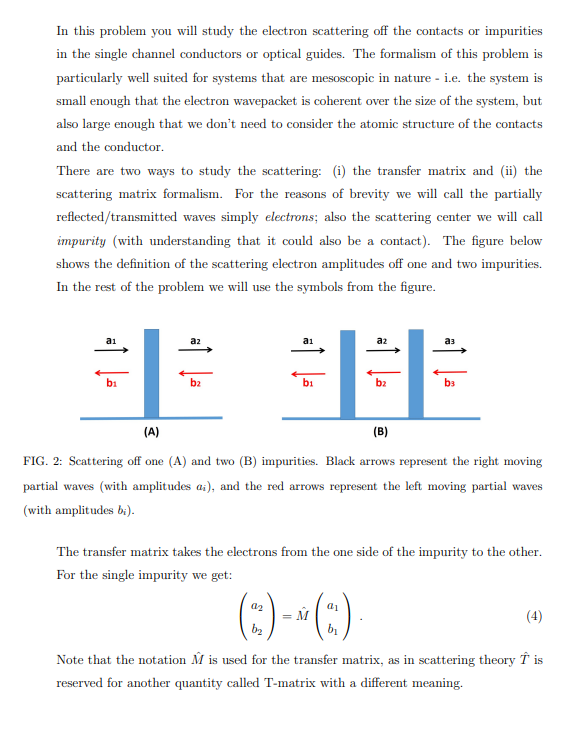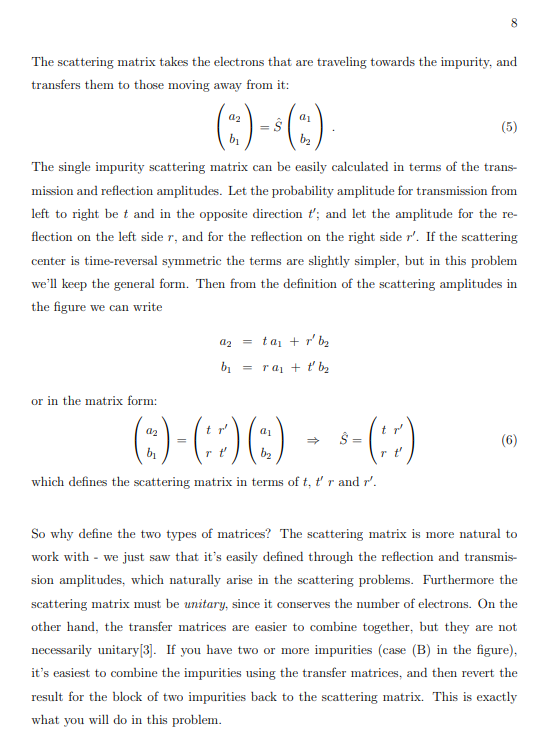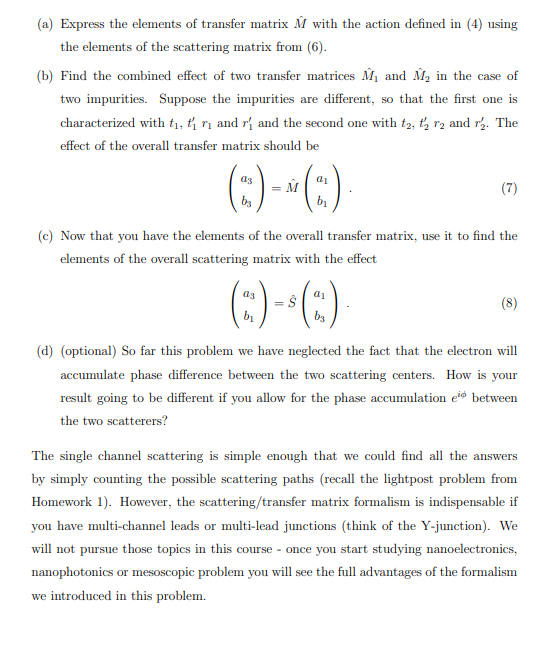


In this problem you will study the electron scattering off the contacts or impurities in the single channel conductors or optical guides. The formalism of this problem is particularly well suited for systems that are mesoscopic in nature - i.e. the system is small enough that the electron wavepacket is coherent over the size of the system, but also large enough that we don't need to consider the atomic structure of the contacts and the conductor. There are two ways to study the scattering: (i) the transfer matrix and (ii) the scattering matrix formalism. For the reasons of brevity we will call the partially reflected/transmitted waves simply electrons; also the scattering center we will call impurity (with understanding that it could also be a contact). The figure below shows the definition of the scattering electron amplitudes off one and two impurities. In the rest of the problem we will use the symbols from the figure. ai az ai a2 bi b2 bi b2 (A) (B) FIG. 2: Seattering off one (A) and two (B) impurities. Black arrows represent the right moving partial waves (with amplitudes ai), and the red arrows represent the left moving partial waves (with amplitudes bi). The transfer matrix takes the electrons from the one side of the impurity to the other. For the single impurity we get: 02 ai (4) b2 Note that the notation is used for the transfer matrix, as in scattering theory T is reserved for another quantity called T-matrix with a different meaning. 8 The scattering matrix takes the electrons that are traveling towards the impurity, and transfers them to those moving away from it: 02 Q1 -) s (5) bi bz The single impurity scattering matrix can be easily calculated in terms of the trans- mission and reflection amplitudes. Let the probability amplitude for transmission from left to right be t and in the opposite direction t'; and let the amplitude for the re- flection on the left side r, and for the reflection on the right side r'. If the scattering center is time-reversal symmetric the terms are slightly simpler, but in this problem we'll keep the general form. Then from the definition of the scattering amplitudes in the figure we can write ' 02 = tai + r' by ra + t' by bi or in the matrix form: 02 ai ()-(2) 3-(0) (6) by which defines the scattering matrix in terms of t, t'r and r'. So why define the two types of matrices? The scattering matrix is more natural to work with - we just saw that it's easily defined through the reflection and transmis- sion amplitudes, which naturally arise in the scattering problems. Furthermore the scattering matrix must be unitary, since it conserves the number of electrons. On the other hand, the transfer matrices are easier to combine together, but they are not necessarily unitary[3]. If you have two or more impurities (case (B) in the figure), it's easiest to combine the impurities using the transfer matrices, and then revert the result for the block of two impurities back to the scattering matrix. This is exactly what you will do in this problem. (a) Express the elements of transfer matrix with the action defined in (4) using the elements of the scattering matrix from (6). (b) Find the combined effect of two transfer matrices and M, in the case of two impurities. Suppose the impurities are different, so that the first one is characterized with t, t n and r' and the second one with tz, t'y r2 and ra. The effect of the overall transfer matrix should be a3 1 M (7) bz bi (c) Now that you have the elements of the overall transfer matrix, use it to find the elements of the overall scattering matrix with the effect 03 di s (8) bi bz (d) (optional) So far this problem we have neglected the fact that the electron will accumulate phase difference between the two scattering centers. How is your result going to be different if you allow for the phase accumulation eid between the two scatterers? The single channel scattering is simple enough that we could find all the answers by simply counting the possible scattering paths (recall the lightpost problem from Homework 1). However, the scattering/transfer matrix formalism is indispensable if you have multi-channel leads or multi-lead junctions (think of the Y-junction). We will not pursue those topics in this course - once you start studying nanoelectronics, nanophotonics or mesoscopic problem you will see the full advantages of the formalism we introduced in this problem. In this problem you will study the electron scattering off the contacts or impurities in the single channel conductors or optical guides. The formalism of this problem is particularly well suited for systems that are mesoscopic in nature - i.e. the system is small enough that the electron wavepacket is coherent over the size of the system, but also large enough that we don't need to consider the atomic structure of the contacts and the conductor. There are two ways to study the scattering: (i) the transfer matrix and (ii) the scattering matrix formalism. For the reasons of brevity we will call the partially reflected/transmitted waves simply electrons; also the scattering center we will call impurity (with understanding that it could also be a contact). The figure below shows the definition of the scattering electron amplitudes off one and two impurities. In the rest of the problem we will use the symbols from the figure. ai az ai a2 bi b2 bi b2 (A) (B) FIG. 2: Seattering off one (A) and two (B) impurities. Black arrows represent the right moving partial waves (with amplitudes ai), and the red arrows represent the left moving partial waves (with amplitudes bi). The transfer matrix takes the electrons from the one side of the impurity to the other. For the single impurity we get: 02 ai (4) b2 Note that the notation is used for the transfer matrix, as in scattering theory T is reserved for another quantity called T-matrix with a different meaning. 8 The scattering matrix takes the electrons that are traveling towards the impurity, and transfers them to those moving away from it: 02 Q1 -) s (5) bi bz The single impurity scattering matrix can be easily calculated in terms of the trans- mission and reflection amplitudes. Let the probability amplitude for transmission from left to right be t and in the opposite direction t'; and let the amplitude for the re- flection on the left side r, and for the reflection on the right side r'. If the scattering center is time-reversal symmetric the terms are slightly simpler, but in this problem we'll keep the general form. Then from the definition of the scattering amplitudes in the figure we can write ' 02 = tai + r' by ra + t' by bi or in the matrix form: 02 ai ()-(2) 3-(0) (6) by which defines the scattering matrix in terms of t, t'r and r'. So why define the two types of matrices? The scattering matrix is more natural to work with - we just saw that it's easily defined through the reflection and transmis- sion amplitudes, which naturally arise in the scattering problems. Furthermore the scattering matrix must be unitary, since it conserves the number of electrons. On the other hand, the transfer matrices are easier to combine together, but they are not necessarily unitary[3]. If you have two or more impurities (case (B) in the figure), it's easiest to combine the impurities using the transfer matrices, and then revert the result for the block of two impurities back to the scattering matrix. This is exactly what you will do in this problem. (a) Express the elements of transfer matrix with the action defined in (4) using the elements of the scattering matrix from (6). (b) Find the combined effect of two transfer matrices and M, in the case of two impurities. Suppose the impurities are different, so that the first one is characterized with t, t n and r' and the second one with tz, t'y r2 and ra. The effect of the overall transfer matrix should be a3 1 M (7) bz bi (c) Now that you have the elements of the overall transfer matrix, use it to find the elements of the overall scattering matrix with the effect 03 di s (8) bi bz (d) (optional) So far this problem we have neglected the fact that the electron will accumulate phase difference between the two scattering centers. How is your result going to be different if you allow for the phase accumulation eid between the two scatterers? The single channel scattering is simple enough that we could find all the answers by simply counting the possible scattering paths (recall the lightpost problem from Homework 1). However, the scattering/transfer matrix formalism is indispensable if you have multi-channel leads or multi-lead junctions (think of the Y-junction). We will not pursue those topics in this course - once you start studying nanoelectronics, nanophotonics or mesoscopic problem you will see the full advantages of the formalism we introduced in this









